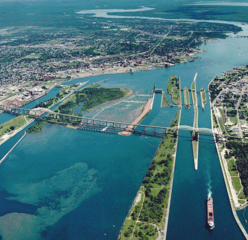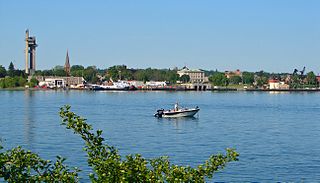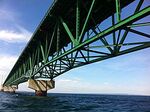Sault Ste. Marie
Sault Ste. Marie is the most important city in the Upper Penisula of the U.S. State of Michigan, at least for everyone unwilling to drive three hours to the west on back roads to reach Marquette.
Etymology[edit]
Sault Ste. Marie is pronounced "Soo Saint," except by Francophones, and is sometimes just called "The Soo." The reason the name is French is that it is cheek-to-jowl with Ontario, which is the part of Canada a thousand miles away from the other part where French is relevant. At current exchange rates, there is no point to driving into Ontario. (It has an imitation Sault Ste. Marie, but it is nothing like the real one despite having four times as many people.) Unless you are having a heart attack and don't feel you will last until next August, there is no reason to drive in the other direction either.
"Ste. Marie" would be Saint Mary of Bible fame. Immaculate son Jesus has no city in Michigan; but then again, He does have most of the entire western part of the Lower Penisula.
"Sault" would be a rapids, if the reader would be French, because there is a rapids separating the real Sault Ste. Marie from the Canadian imitation.
Soo Locks[edit]
The rapids are an obstacle to shipping. If a barge full of Coca Cola or beer were to pass Sault Ste. Marie, the eventual customer would get foam sprayed all over his face when he pulled the pop-top. Indeed, it would not have mattered at all if the Edmund Fitzgerald "♪♪ would have made Whitefish Bay if she'd put fifteen more miles behind her ♪♪" (Gordon Lightfoot), if it had gone on to be split into pieces trying to run the rapids, which is not the Rivière Sainte-Marie or some such thing, but the Saint Marys [sic] River.
To solve this problem, America built the Soo Locks. This ensured that no one could get a ship down the river without the correct key for the locks. As in the early television program Seven Keys, there are four locks, which means skippers can try everything on their keychains to see if they can get through. As is the case in baseball (before it went to three divisions), two of the locks are the American and the other two are the National.
| Name | Description | Drop | 
|
|---|---|---|---|
| Polack | This first-ever lock was built by the Polacks in 1895. The first thing to pass through it was Don Fleming, who coined the phrase, "First time in this category!" heard so often on Jeopardy! At the time, it was the largest in the world, but these days, that and a quarter will get you a cup of coffee, provided you have six other quarters (and a seventh if you tend to tip). It was rebuilt in 1968 in honor of the election of Richard Nixon. | 21 ft (7 m) | |
| Davis Lock | This tiny lock, built in 1914, is used only for piddling ships, tour boats, and pleasure craft, and only when attendants are in the mood to turn the cranks for them. Wars were getting Great but lockbuilders seemed to think ships would just keep getting smaller. | 21 ft (7 m) | |
| Sabin Lock | This lock was built in 1919. They really had more luck with the vaccine of the same name than they did with this lock. They only did it because of their success building the other ridiculously small one in 1914. The Sabin's only current use is to store recyclables where the homeowner neglected to soak off the labels. | 21 ft (7 m) | |
| MacArthur Lock | This lock was built in 1943, as though the nation did not have more pressing concerns, what with a war being fought on two fronts, and all. | 21 ft (7 m) |
Since 1986, the plan has been to replace Davis and Sabin with a so-called Sooper-Lock that will not be ridiculously small. No funds have been appropriated to actually do the work, but once they break ground and all the water starts emptying out of Lake Superior, funding will be forthcoming, perhaps in the same Congress, as both political parties try to avoid being blamed for a delay.
It is redundant to call them the Soo Locks. That is like saying the Rapids Locks, and all locks have to do with rapids (or rapidses, which is the plural). It is as redundant as referring to the Atlantic Coast as the Seacoast, though people in New Hampshire do so and it doesn't bother them a bit. The Soo Locks, then, are really the Saint Marys [sic] Locks. That is just a fact the Powers That Be don't want you to know.
- Lakers
The largest ships that take the Soo Locks, named lakers after the basketball team at Grand Valley State or perhaps Los Angeles, are so-called because they cannot fit through the Welland Canal that bypasses Niagara Falls, and are stuck above it, moving goods between Erie or Cleveland and the bustling communities on the shore of Lake Superior. Surely the reader can think of a couple, Thunder Bay perhaps. Depending on the terms of lading, some ships find it expedient to bypass the Welland Canal and go down Niagara Falls itself, despite the Coca Cola dilemma noted above, but none has ever tried to go up it. Thus, once over the Falls, a laker is "devirginized," as it obviously has no way to return to the Soo Locks. There may also be bleeding.
Lakers must use the MacArthur Lock, despite the famous popular song that describes its "sweet green icing flowing down." If the Sooper-Lock is built, it will tempt larger ships that would be even more certain to get stuck in the Welland Canal.
A lot of people visit Niagara Falls on their honeymoons, but damned few are interested in taking a container ship for a memorable three-week "side trip" through the Soo Locks.
Teams of the local Lake Superior State University are also the Lakers, because they are just as incapable of getting out of their conference and into the post-season. Like the ships, athletes of the collegiate Lakers may get devirginized and may refuse to ever return to the Soo.
History[edit]
Sault Ste. Marie was settled by the Indians around 1500 and by the Europeans, when the Indians were chased away in 1668. Father Jacques Marquette founded a Catholic mission there, which is dumb, because again, Marquette is a long drive to the west. Later, there was a trading post, which attracted trappers and Indians (who were easily trapped). It was a key truck-stop on the route from Montreal to the land to the northwest of it, long before trucks, and all who wanted to visit really barren, icy wasteland had to pass through Sault Ste. Marie to get to it.
The city grew peacefully until 1817, when the young United States finally reached puberty and decided it needed a penisula (and then two). A Joint Boundary Commission decided to draw a line right down the middle of the Saint Marys [sic] River. After ten years of seeing various drawing materials, from tempura to sawdust, washed away by the natural action of the river, the Commission voted that it would suffice to merely imagine such a line. This vote cleaved Sault Ste. Marie into the Michigan city to the south and the cheap imitation to the north. Ontario could save face only by adding a hyphen.
Economy[edit]
Transportation[edit]
Sault Ste. Marie is served by two thoroughfares:
- I-75, for wheeled traffic, which is free provided you neither cross into Canada nor back into the Lower Penisula, and
- I-500, for snowmobiles.
Importantly, there is no I-anything to the west, such as to Marquette or Michigan Tech.
Shipping[edit]
The Soo Locks (see above) are almost the only way to get a ship all the way through the Saint Marys [sic] River, which makes them notable. One can try the rapids — or the channel, turbines, and sluiceway of the municipal power plant — but liability concerns lead most skippers to take the "safe bet" of the Locks.
One remaining alternative is a lock on the Canadian side, which can accommodate small kayaks as well as most swim toys.
Media[edit]
The region's only newspaper is the Sault Ste. Marie Evening News, which the locals refer to as the Evening News, as they tend to know where they are, not that they are overjoyed about it.
Television comes in on Channels 8 and 10, but both are rebroadcasts of stations in "upper Michigan," by which people mean upper lower Michigan (that is, places like Cadillac), and not upper Michigan. Those with cable receive rebroadcasts from lower lower Michigan (that is, places like Detroit). Those without cable contrive to put together ever-longer rabbit ears and perhaps pull in places like Cheboygan or Ishpeming. They tend not to have any working coat hangers left in their homes.
Tourism[edit]
Thousands of tourists who are not interested either in shipping or opening an agitated can of beer nevertheless come to the Soo Locks to see this engineering marvel. Watching the water slowly rise or fall so that a ship can go out the other end from the one it came in is the same thrill as watching grass grow or paint dry, and it doesn't take nearly as long. Parents must not mention to their children that they can get the same thrill with water levels in the bathtub, or they will never get any homework done.
Once a year on Engineers' Day, the public is allowed past the security checkpoint and can get close enough to the Soo Locks to stow away aboard a container ship or to fall into the canal and have to be fished out.
Wikipedia tells us that the reason Sault Ste. Marie is much smaller than the cheap imitation on the Canadian side is that there is relatively nothing near it. The only substantial city in that part of the state is Stignace, on the north end of the Troll Bridge. Marquette, where there might be a Walmart, is hours away — perhaps days, if you are following a farm tractor that won't pull over.
Tourists from places like Detroit, however, come to the Upper Penisula all the time, craving a part of Michigan that is free from social workers, panhandlers, and Negroes. Unfortunately, once they arrive, they find a terrain that, where it isn't open swamp, is flat and unremarkable, and inhabitants who, while white, flout the traits that were only rumored about Sarah Palin's family, and share the same accent ta boot. It is a part of America where high-school beauty queens almost always have a tooth missing or a spider tattoo on their necks. Consequently, most tourists take a couple photographs of Taquamenon Falls without getting out of the car, take refuge at Sault Ste. Marie, take in a movie, and take the Hell off.
See also[edit]
| |||||||||||||||||



